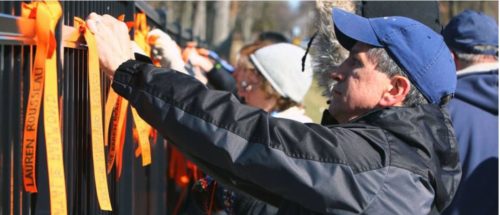CROWN POINT, Ind. — Pagan blogger John Halstead helped to organize a two-day protest at a gun show here on March 3-4. People protested against the sale of military-style assault weapons like the AR-15 at the Lake County Fairgrounds.

Protestors place ribbons on a fence during a gun show protest in Crown Point, Indiana [John Halstead].
Pagan practice and political activism
Rabbi Abraham Heschel described the Selma to Montgomery civil rights march as, “Praying with your feet.” Halstead took that phrase as the title for one of his blogs, “Pray with Your Feet.” Halstead said, “My activism has helped me to grow spiritually in ways in which I don’t think I ever could have with more inwardly-focused practices.” For Halstead, Pagan practice and political activism reflect the same underlying change process.
Halstead noted similarities between activism and spirituality. Both use group chanting and symbolism to evoke emotion. People design political protests and Pagan rituals to raise emotional or psychological energy. He said, “There is a kind of ‘magic’ to protesting,” not in the sense of ‘mind over matter,’ but a ‘matter over mind’ magic. Halstead feels that political demonstrations can be transform the actor, raising energy and consciousness. This energy can recharge veteran activists and inspire newcomers. It can also prevent burnout.
Religion and spirituality have the power to move people. Halstead stressed, “Activists on the left shouldn’t surrender the power of religion to people on the right.”
Halstead stressed that successful protests have to be part of a long-term strategy. That strategy includes rejecting a cultural bias in favor of individual actions. Those individual actions cannot fix collective problems. People have greater power than they realize, but only when they act together. Collective action can heal isolation through creating community.
The U.S. has a cultural bias in favor of short-term solutions to all problems. Halstead stressed, “Systems of oppression were not created overnight and probably won’t collapse overnight.” Local actions may not achieve immediate goals, but they can become part of a larger “cultural shift.”
The protest itself
This two-day protest drew about 150 people, according to Halstead, lasting each day for three hours. The protest memorialized the 17 victims of the Parkland shooting. The activists made crosses or stars of David for each victim and placed these markers in the ground. Activists played two tapes. First, they heard “The President Sang ‘Amazing Grace'” by Zoe Mulford. Next, they heard an original composition about the shootin, composed by the members of the drama club in Marjory Stoneman Douglas high school.
The protest acknowledged victims of other school shootings. Protesters tied orange ribbons to the fence around the fairground. Each ribbon had the name of one of the 300 victims of shootings since Columbine in 1999.
The protesters wanted to ban sales of bump stocks and military-style assault weapons at the county fairgrounds. The protest also sought to end unregistered private sales at gun shows. Halstead felt that they achieved great press coverage in the local papers. The county commissioners subsequently decided to vote on a gun control resolution.
Halstead differentiated electoral politics, exercising the right to assemble, and direct action. In electoral politics, people work ”within the existing political channels, like voting.” Marching and demonstrating form part of that existing political process. The First Amendment protects them under freedom of speech and assembly. Halstead likened these First Amendment rights to muscles, “We need to exercise them, like a muscle, or we will lose them through disuse.” According to Halstead, “Direct action attempts to work outside of those channels.” If the protest at the gun show had blocked the entrance, it would have been direct action.
Naturalism and humanism
Many people think of Halstead as humanistic Pagan, but he now identifies as a naturalistic animist. Some humanistic Pagans have begun to prefer the term “naturalistic” to “humanistic,” according to Halstead. Animism, in particular, rejects the human emphasis of humanism.
Halstead writes for the Huffington Post, Patheos, and Gods and Radicals. He manages humanisticpaganism.com and edited the book Godless Paganism: Voices of Non-Theistic Pagans. He was the principal facilitator of “A Pagan Community Statement on the Environment.”
The Wild Hunt is not responsible for links to external content.
To join a conversation on this post:
Visit our The Wild Hunt subreddit! Point your favorite browser to https://www.reddit.com/r/The_Wild_Hunt_News/, then click “JOIN”. Make sure to click the bell, too, to be notified of new articles posted to our subreddit.